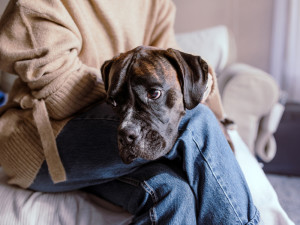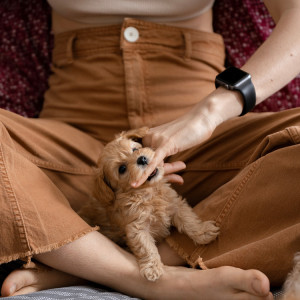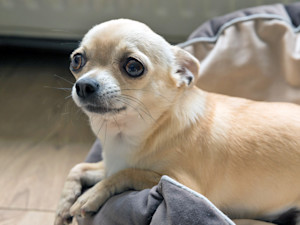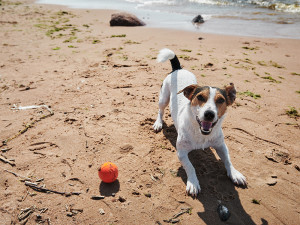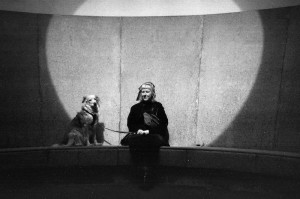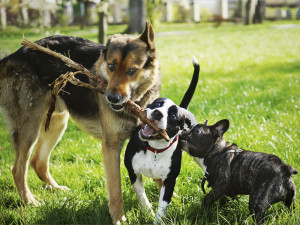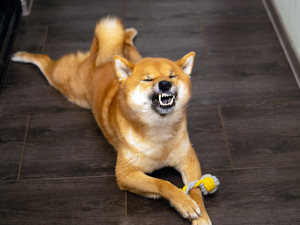How to Tell If Your Dog Is Just Playing (& When to Step In If They’re Not)
It’s all fun and games... until it’s not
Watching my dog Lucy get into a play bow – her legs hitting the floor, bum high in the air, back deeply arched – sets my heart alight. She’ll let out a low growl or a ‘woof’ if she’s extra happy, and there’s nothing like it. Lucy’s selective about the dogs she engages with, so I feel extra special when she plays with me, her mere human.
But it’s taken me a long time to learn the subtleties of Lucy’s body language: the way she uses her mouth (sometimes a snap is a warning, sometimes she’s playing); the difference between her growls (the one where she’s having too much fun compared with the one she saves for the vet); and the way she paws at me when she wants me, it didn’t happen overnight.
So I was fascinated by an Instagram video posted by Lorna Sandbachopens in new tab, a canine conditioning specialist. In the video, Lorna’s German shepherd, Rio, is gently mouthing Lorna’s hand, teeth grazing against her skin. “If you think your dog is just playing with you…you’re wrong,” Lorna captioned the video. “This isn’t play and it’s not aggression, either.” She says that instead, it’s a sign of pain. Which got me thinking, how do we truly know when our dogs are playing? And if they look like they’re playing and they’re not, then what else is really going on? Let’s get into it.
What does your dog look like when they’re playing?
First up, all dogs play in different ways. “Some like to ‘body slam’, running into each other at full speed and slamming into each other,” says Rima Chehlaoui, a behaviourist at Even Better Dogs K9 Behaviour and Trainingopens in new tab. “Some chase each other, others use their paws and noses to touch one another, and some like to tug with friends.”
Lots of dogs interact using their jaws, teeth and tongue, – what’s called ‘mouthing’ or ‘play-biting’ – explains Rima. “It’s their instinctual programming to play with their littermates and other dogs by jaw-wrestling and inhibited biting,” continues Rima, “and most dogs attempt to play with humans in this way, too – especially during puppyhood when the urge to use their mouth is strongest.”
Recognising play vs aggression
When you first witness dogs at play, it can be hard to know what’s going on. Are they real fighting? Or is it play-fighting? Are they OK? Rima explains that during play there can often be a lot of growling and what she calls ‘imitation aggression’ – when dogs mimic aggressive behaviour as part of play, such as growling and wrestling, but without any actual intent to harm.
“It can look and sound like true aggression – as it’s loud and scary,” she explains, “but it’s usually nothing to worry about. It’s practice for dog-on-dog social behaviour.”
When I speak to Lorna, she suggests that for a lesson in dog play, head to somewhere where play can be “tense” like a dog park, for instance. Yes, “the dogs are playing, but they don’t necessarily know each other,” she explains. In contrast, play when dogs know each other is more relaxed. “It's like us humans, if we’re with a mate or a partner, we’ll lounge around,” she explains, “but in a group of people you’ve just met, you’re not as relaxed, right?”
Rima says that when dogs are playing in a healthy manner, you’ll see loose, bouncy movements that flow freely. “It will have an equal feel to it,” she explains, “so as they’re moving you’ll see one on top then the other and it will flow. There will be vocalisations such as barking and growling, but the barking will be quick, loud woofs. The growling will seem relaxed and happy, and not anxious, nervous or defensive. They may also grunt and pant.”
When should you step in? Recognising when play becomes too rough
Rima advises not to interfere with dog-on-dog play unless one of the dogs is much larger than the other, much more physically fit (ie, puppy/senior dog) or much shyer. “But you should step in should you see your dog desperately attempting to get away,” says Rima.
Always keep an eye on your dog when they’re playing with others, and observe the way the play looks – is it becoming serious? Then step in to break up rough dog play if it gets too exciting. “If your dog struggles with their arousal levels, it can sometimes tip into a fight,” says Rima, so it’s up to you to regulate that and enforce breaks, for both your dog and the other dog.
Potential signs of stress
“Things can also escalate when you have a group of dogs and they gang up on one dog,” adds Rima. Look out for change: has your dog stiffened up? Or has the growl changed? Or maybe they’re ‘shaking off’, which releases adrenaline. “Dogs do this after both exciting and stressful situations,” explains Rima.
“But, play-biting between dogs is a nice way for the dogs to enjoy themselves, and is important for maintenance of social skills,” Rima explains. But if you feel something isn’t right, “go with your gut,” she says. “Don’t listen to people in the park, everyone has their own idea of what is OK.”
However, Rima does warn against allowing your dog to play with you using their mouth – especially “teeth on skin”, she warns. “A dog that has extensively been allowed to use their mouth might snap to communicate,” she says. If your dog starts to use their mouth while playing, simply stop playing, then start again once they’ve stopped using their mouth. Keep your own play sessions with your dog short and sweet. But if you’re worried, Rima advises seeking the help of a professional behaviourist.
If your dog isn’t playing, what else could be going on?
Context is key. “You have to look at the whole picture,” explains Lorna. “When my Collie plays, he’s growly and bites, but that’s him having fun.” In contrast, Rio (her German Shepherd) doesn’t play that way, and so when Lorna touches her – like in the video – Rio’s mouthing because she’s in pain. “And if you look at her body language, she’s not relaxed,” explains Lorna.
Signs of pain vs play
You need to look at your dog’s body as a whole. If your dog is growling, for example, what else is going on? “A playful growl often comes with soft lips, relaxed facial expressions and bouncy movements, like a play bow.” says Rima. “In contrast, a serious growl is more guttural, with a ‘hard’ look, stiff body language and bared teeth.
The truth about tails
There’s also the misconception of a dog’s wagging tail. Turns out, it doesn’t always mean they’re happy. “I think this is the most common myth,” says Rima, “but dogs communicate with their whole body.”
The tail wag can indicate a broad range of emotions. “A ‘happy wag’ will be a circular loose wag and their whole bum will be going around with it,” says Rima. “Think of a floppy soppy dog!”
But their tail can also indicate nervousness, curiosity or discomfort. When your dog is unsure about a situation, their tail might move back and forth ever so slightly in a subtle way. A reactive or anxious tail wag is vertical and extremely fast. Their body will also be rigid and very different to the looseness of play.
Most importantly, “when a dog first comes into your life you have to learn their own unique language, their boundaries and what they like,” explains Lorna. “Never expect your dog to be the same as another dog.” Rima says to think of it as ‘nature vs nurture’: “each dog will have a unique set of experiences and environments that makes them who they are.”
It’s up to you to learn how to communicate with them in their own way – and stand up for them at the park if you think the play has gone too far. “You know your dog the best,” continues Lorna, so if there’s something subtle that changes – “it could even be the way a patch of their hair is standing out differently to usual, which sometimes indicates pain or fear” – get the help they need.


